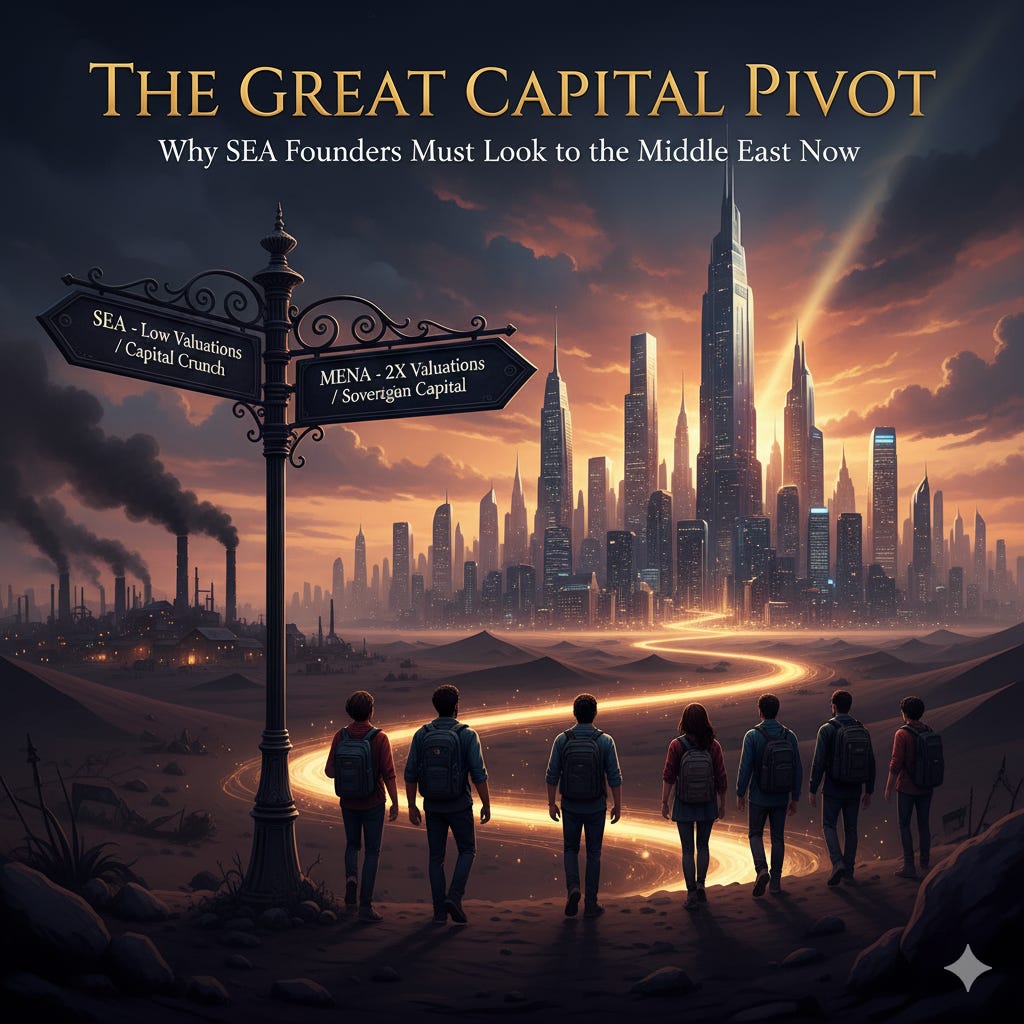The Great Capital Pivot: Why SEA Founders Must Look to the Middle East Now
The "Asian Tiger" is napping. The "Gulf Falcon" is hunting.
For the last decade, Southeast Asia (SEA) was the darling of emerging market venture capital. But as we settle into late 2025, the wind has shifted violently. While SEA founders scrape for flat rounds in a liquidity crunch, their counterparts in Riyadh and Abu Dhabi are closing Series A rounds at valuations significantly higher than the SEA average.
There is a whisper in Singapore and Jakarta: “The Middle East is a bubble.”
They are wrong. And if you are a founder building in SEA, believing that myth could be the most expensive mistake of your career.
Here is the data-backed reality of why the smart money—and the smart founders—are migrating from the Malacca Strait to the Arabian Gulf.
1. The Flip: MENA Has Officially Overtaken SEA
For the first time in history, the data proves the shift is real. According to MAGNiTT’s Q3 2025 Report, the MENA ecosystem raised $3 Billion in the first nine months of 2025, overtaking Southeast Asia in total venture funding volume.
SEA Reality: Deal volume is stagnating. Global LPs, spooked by interest rates and geopolitical tension, have pulled back.
MENA Reality: In Q3 2025 alone, MENA startups raised $1.2 Billion. Saudi Arabia specifically saw $860 Million deployed in H1 2025—a 116% increase YoY compared to 2024.
While SEA founders are facing down rounds, Saudi founders are seeing record capital deployment. This isn’t a “bubble”—it’s a correction of capital flows toward growth.
2. The “Bubble” Myth: Tourist vs. Sovereign Capital
Skeptics argue that the Middle East is in a hype cycle that will burst. This stems from a fundamental misunderstanding of whose money is fueling the ecosystem.
In 2021, the SEA bubble was inflated by Tourist Capital—hedge funds and cross-over investors from the US/Europe. When the market turned, they fled.
The Middle East’s current surge is fueled by Sovereign Capital. The LPs are not pension funds in Ohio looking for a quick flip; they are the governments themselves, investing for Vision 2030.
Saudi Arabia: Jada Fund of Funds and SVC (Saudi Venture Capital) are the anchor LPs. They don’t panic-sell. They are mandated to deploy capital to diversify the economy.
UAE: Mubadala and ADIA are effectively essentially writing the checks that trickle down to early-stage VCs.
Qatar: QIA has launched massive fund-of-funds initiatives to attract top-tier VCs to Doha.
The Insight: This “bubble” is made of reinforced steel. If the market dips, the LPs (Government) will likely increase spending to support the ecosystem, not pull back.
3. The “Buy Local” Moat: Native Apps Are Winning
In SEA, local apps often bleed market share to global giants or struggle with monetization (low ARPU). In the Gulf, “Native” is the winning strategy.
Fintech Dominance: Saudi Arabia hit 79% cashless transactions in 2024, beating its 2025 target a year early.
The Winners: Look at the top charts. It’s not just PayPal or Uber. It’s STC Bank, Urpay, and Jahez.
Tabby & Tamara: These local BNPL players didn’t just copy Klarna; they out-executed global players by integrating deeply with local Islamic finance regulations and consumer culture.
Unlike the low-basket-size economy of parts of SEA, the GCC offers High ARPU (Average Revenue Per User) combined with a fierce loyalty to local champions.
4. The VC Migration: Following the Money
Perhaps the strongest signal is the movement of the “Smart Money.”
Southeast Asian VCs are quietly (and sometimes loudly) opening shops in Riyadh, Doha and Abu Dhabi. Why?
The LP Void in SEA: Fundraising from traditional Western LPs has dried up for SEA funds.
The LP Feast in GCC: GCC Sovereign Wealth Funds are currently the most active allocators to VC funds globally.
We are seeing funds with Asian roots, like MSA Capital and global players with strong SEA footprints like 500 Global, doubling down on their MENA presence. They know that in a dry global market, the GCC is the only oasis with deep reservoirs of liquidity.
The Playbook for SEA Founders
You have an unfair advantage. You know how to build for:
Super-app ecosystems (Grab/GoTo model).
Mobile-first populations.
Operationally heavy logistics/fintech environments.
The Middle East today looks like SEA five years ago—but with 10x the purchasing power and a government that is effectively paying you to enter the market.
The Verdict: Stop waiting for the funding window to reopen in Singapore. The door is wide open in Riyadh.
Next Steps for Founders
Research the Incentives: Look immediately at the NTDP (National Technology Development Program) in Saudi Arabia. They offer “Relocate” grants that can cover your burn rate as you set up.
Audit Your Cap Table: Ask your current investors if they have connections to Jada, SVC, or Hub71.
Study the Leaders: Download Tamara, Nana, and Salla. Their UX and business models are the blueprint for what succeeds here.


